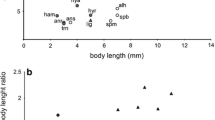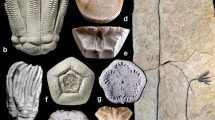Summary
Based on a morphological and functional analysis of the tergal tubercles of the desert woodlouse Hemilepistus reaumuri, 12 types of morphologically and/or functionally different tergal tubercles in terrestrial isopods were investigated.
Morphological investigation of Hemilepistus reaumuri showed that the number of tubercles remains constant during ontogeny and that the individuality of the tuberculation as a whole is unaffected by the moult. The morphogenesis of a single tubercle is brought about by locally increased mitotic rates of the epidermis cells.
In Hemilepistus reaumuri the tubercles function as a digging device.
For the other 11 types of tuberculation the morphology of the single tubercles and their arrangement on the tergites are analyzed. For Oniscus, Porcellio, Ligia oceanica, the granulated species of Armadillidium, and Bathytropa granulata an increased resistance to bending of the tergites is considered as the mechanical function of the tubercles. In Ligia oceanica and the species of Armadillidium this mechanical function serves primarily to increase the effectiveness of a clinging behavior as protection against predators. In Oniscus and Porcellio the primary purpose is to avoid too much water loss by transpiration. In species which can roll up into a ball, such as Pentheus tuberculatus and Polyacanthus aculeatus, the tuberculation has been transformed into an apparatus for protection from predators according to the hedgehog principle. In Stegosauroniscm an increase of the diameter is achieved by the tubercles; this probably also serves as a means of avoiding certain predators. The mechanical function of the ridges in Haplophthalminae, some Bathytropa- and Platyarthrus-species and Buddelundiella could not be found; from a biological point of view the ridges seem to form part of a defense system.
Finally the author analyzes the ecological steps that were undertaken by isopods in the course of their conquest of the land and the role the tergal tubercles played in this process.
Zusammenfassung
Ausgehend von einer morphologischen and funktionellen Analyse der Tergithöcker bei der Wüstenassel Hemilepistus reaumuri wurden 12 in morphologischer und/oder funktioneller Hinsicht verschiedene Formen von Tergithöckerung bei Landisopoden untersucht.
Die morphologische Untersuchung von Hemilepistus erbrachte, daß die Zahl der Höcker während der Ontogenese konstant bleibt and daß die Individualität der Höckerung über die Häutung hinweg gewahrt bleibt. Die Morphogenese der Höcker wird durch vermehrte Teilungen der Epidermiszellen im Höckerbereich bewirkt.
Die Funktion der Höcker bei Hemilepistus reaumuri und den anderen Hemilepistus-Arten ist die eines Grabapparates.
Von den übrigen 11 Höckerungs-Typen wurde die Morphologie der einzelnen Höcker und ihre Verteilung auf den Tergiten dargestellt. Als Funktion der Höcker von Oniscus, Porcellio, Ligia oceanica, den gehöckerten Armadillidium Arten and Bathytropa granulata wird eine mechanische Steigerung der Biegefestigkeit der Tergite erachtet, die im Falle von Ligia oceanica und den Armadillidium-Arten dem Feindschutz mit Hilfe eines Anklammerverhaltens dient, wogegen bei Oniscus and Porcellio in erster Linie durch ein Anpreßverhalten ein zu hoher Wasserverlust durch Transpiration vermieden wird. Bei Arten mit Einrollungsvermögen wie Pentheus tuberculatus und Polyacanthus aculeatus wurde die Höckerung zu einem Feindschutzapparat nach dem Igel-Prinzip umfunktioniert; bei Stegomuroniwus wird durch die Höcker eine Vergrößerung des Maximal-Durchmessers erreicht, die wahrscheinlich ebenfalls einen Feindschutz bewirkt. Die mechanische Funktion der Rippen von Haplophthalminae, einiger Bathytropa-und Platyarthrus-Arten Bowie von Buddelundiella konnte nicht geklärt werden; in biologischer Hinsicht scheinen these Rippen jedoch ebenfalls einen Teil eines effektiven Feindabwehrsystems darzustellen.
In einer Schlußbetrachtung werden die einzelnen ökologischen Schritte der Landeroberung der Isopoden und ihre Beziehungen zur Tergithöckerung dargestellt.
Similar content being viewed by others
Literatur
Arcangeli, A.: Note Isopodologische. — Il genere Platyarthrus. Atti Sec. ital. Sci. nat. 60, 189–210 (1921)
Arcangeli, A.: Exploration du Pare National Albert, Mission H. Damas (1935–1936) Isopodi terrestri. Inst. Pares Nationaux du Congo Belge Fasc. 15 (1950)
Auzou, M. L.: Recherches biologiques et physiologiques sur deux isopodes onisciens: Porcellio scaber Lat. et Oniscus asellus L. Ann. Sci. nat., Zoologie, 11. ser., 15, 71–98 (1953)
Barnard, K. H.: Contributions to the Crustacean Fauna of South Africa. No. 11. Terrestrial Isopods. Ann. S. Afr. Mus. 30, 179–388 (1932)
Caruso, D.: Una nuova specie di isopodo terrestre di Sicilia (Arthropoda, Crustacea). Boll. Sed. Accad. gioenia Sci. nat., Ser. IV, 11 (11/12), 95–103 (1973a)
Caruso, D.: Isopodi terrestri delle isole Egadi. Boll. Sed. Accad. gioenia Sci. nat., Ser. IV, 11 (11/12), 69–94 (1973b)
Dudich, E.: Die Kalkeinlagerungen des Crustaceenpanzers in polarisiertem Licht. Zool. Anz. 85, 257–264 (1929)
George, R. W., Sheard, K.: Ecdysis in the isopod Porcellio scaber (Latreille). Aust. J. Zool. 2, 75–85 (1954)
Gruner, H.-E.: Über das Coxalglied der Pereiopoden der Isopoden. Zool. Anz. 152, 312–317 (1954)
Gruner, H.-E.: Krebstiere oder Crustacea. V. Isopoda, 1. u. 2. Liefg. In: Die Tierwelt Deutschlands, 51. u. 53. Teil. Jena: Fischer 1965–1966
Herold, W.: Beiträge zur Anatomie und Physiologie einiger Landisopoden. Häutung, Secretion, Atmung. Zool. Jb. Abt. Anat. u. Ontog. 35, 455–526 (1913)
Kaestner, A.: Lehrbuch der Speziellen Zoologie, Bd. I, Wirbellose, 2. Teil, Crustacea, 2. Aufl. Stuttgart: Fischer 1967
Linsenmayr, K. E., Linsenmayr, Ch.: Paarbildung und Paarzusammenhalt bei der monogamen Wüstenassel Hemilepistus reaumuri (Crustacea, Isopoda, Oniscoidea). Z. Tierpsych. 29, 134–155 (1971)
Silva, J. de Loyola e: Especies de Sphaeromene Barnard 1914, de colecao do U. S. Nat. Mus. (Isopoda-Crustacea). Bol. Univ. Fed. Parana Zool. 2 (9), 121–137 (1966)
Nicholls, A. G.: Studies on Ligia oceanica. I. u. II. J. mar. biol. Ass. U.K. 17, 655–706 (1931)
Schmölzer, K.: Ordnung Isopoda (Landasseln). In: Bestimmungsbücher zur Bodenfauna Europas, Liefg. 4 u. 5. Berlin: Akademie-Verlag 1965
Schmölzer, K.: Die Landisopoden der Iberischen Halbinsel. Monografias de Cienia Moderna No. 80, 161 S.+10 Verbreit.karten (1971)
Schmölzer, K.: Landisopoden aus Zentral- und Ostafrika (Isopoda, Oniscoidea). S.-B. öst. Akad. Wiss., math.-nat. KI., Abt. I, 182, 147–200 (1974)
Schneider, P.: Lebensweise und soziales Verhalten der Wüstenassel Hemilepistus aphganicus Borutzky 1958. Z. Tierpsych. 29, 121–133 (1970)
Schneider, P., Nauroz, M. K.: Beitrag zur Morphologie, Wachstum und Augenentwicklung der afghanischen Wüstenassel Hemilepistus aphganicus Borutzki, 1958 (Isopoda, Oniscoidea). Crustaceana, Suppl. 3, 110–116+2 Tafeln (1972)
Strouhal, H.: Stark gehöckerte und bestachelte Armadillidiidae. Zool. Anz. 108, 291–304 (1934)
Strouhal, H.: Die Haplophthalminen-Untergattung Calconiscellus Verh. (Oniscoidea - Trichoniscidae). S.-B. öst. Akad. Wiss., math.-nat. KI., Abt. I, 157, 267–282 (1948)
Strouhal, H.: Die Oniscoideen-Fauna der Juan-Fernandez-Inseln (Crustacea, Isopoda terrestria). Ann. naturh. Mus. Wien 64 (1960), 185–244 (1961a)
Strouhal, H.: Eine neue Höckerassel von Korfu (Isop. terr.). Ann. naturh. Mus. Wien 64, 178–184 (1961b)
Vandel, A.: Isopodes récoltés dans les grottes de la Crète parle Docteur K. Lindberg. Notes biospéol. 12, 81–101 (1958)
Van Name, W.: Isopods collected by the American Museum Congo Expedition. Bull. Amer. Mus. Nat. Hist. 43, 41–108 (1920)
Verhoeff, K. W.: Über palaarktische Isopoden. 8. Aufsatz: Armadillidien der Balkanhalbinsel und einiger Nachbarländer, insbesondere such Tirols und Norditaliens. Zool. Anz. 25, 241–255 (1902)
Verhoeff, K. W.: Über paläarktische Isopoden. 9. Aufsatz: Neuer Beitrag zur Kenntnis der Gattung Armadillidium. Zool. Anz. 31, 457–505 (1907a)
Verhoeff, K. W.: Über paläarktische Isopoden (10. Aufsatz). Zur Kenntnis der Porcellioniden (Körnerasseln). S.-B. Ges. naturf. Freunde Berl. 8, 229–281 (1907b)
Wieser, W.: Über die Häutung von Porcellio scaber Latr. Zool. Anz., Suppl. 28, 178–195 (1965)
Author information
Authors and Affiliations
Additional information
Konstruktionsmorphologie Nr. 32 [Konstruktionsmorphologie Nr. 31 s. Reif, W. E., Robinson, J.A.: N.Jb. Geol. Paläont. Mb. (im Druck)].
Rights and permissions
About this article
Cite this article
Schmalfuß, H. Morphologie, funktion und evolution der Tergithöcker bei landisopoden (Oniscoidea, Isopoda, Crustacea). Z. Morph. Tiere 80, 287–316 (1975). https://doi.org/10.1007/BF00302762
Received:
Issue Date:
DOI: https://doi.org/10.1007/BF00302762




